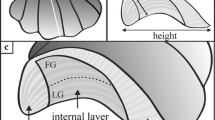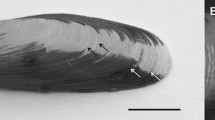Abstract
A set of 370 tests of the irregular echinoid speciesEchinocyamus pusillus from 15 European locations (Baltic Sea, North Sea, Atlantic Ocean, Mediterranean Sea), representing a salinity range between 22 and 39% and a variability in annual average temperatures between 9.5 and 20°C, were analyzed for their Mg content by X-ray diffraction. For 50 of these samples — from all sampled sites — the δ18O and δ13C values were measured additionally. The data are discussed in the context of physiological and environmental (salinity, temperature) control.
The Mg content of the skeletons strongly correlates with the average annual temperature but not with salinity while the δ18O values seem to be influenced by physiological as well as environmental parameters. The oxygen and partly also the carbon isotope data are clearly correlated with the salinity, reflecting the dominant influence of the isotopic composition of the ambient seawater. On the other hand, for samples from biotopes with constant salinity but varying temperatures the temperature dependency on18O fractionation is clearly monitored in the skeletons. However, for most of the non-Mediterranean samples the measured δ18O values are more positive than the expected equilibrium values, probably as a result of vital effects. The degree of this disequilibrium decreases with increasing temperature, with sea urchins from the warmest marine environments of the eastem Mediterranean Sea precipitating their skeletons in or near equilibrium.
Similar content being viewed by others
References
BERGER, W.H., 1981, Paleoceanography: the deep sea record.In Emiliani, C., ed., The sea, Wiley, New York, p. 1437–1519.
BRATTSTRÖM, H., 1941, Studien über die Echinodermen des Gebietes zwischen Skagerrak und Ostsee, besonders des Öresunds:Undersökn över Öresund, 27.
BROECKER, W.S., 1989, The salinity contrast between the Atlantic and Pacific ocean during glacial time:Paleoceanography, v. 4, p. 207–221.
CARPENTER, S.J. and LOHMANN, K.C., 1995, δ18O and δ13C values of modern brachiopod shells:Geochimica et Cosmochimica Acta, v. 59, p. 3749–3764.
CHAVE, K.E., 1954, Aspects of the biogeochemistry of magnesium.-1. Calcareous marine organism:Journal of Geology, v. 60, p. 190–192.
CLARKE, F.W. and WHEELER Jr., B.D., 1917, The inorganic constituents of marine invertebrates:US. Geological Survey Professional Papers, v. 102, 56 p.
CLARKE, F.W. and WHEELER Jr., B.D., 1922, The inorganic constituents of marine invertebrates:US. Geological Survey Professional Papers, v. 124, 62 p.
CRAIG, H., 1966, Isotopic composition and origin of Red Sea and Salton Sea geothermal brines:Science, v. 154, p. 1544–1548.
CRAIG, H. and GORDON, L.I., 1965. Deuterium and oxygen-18 variations in the ocean and the marine atmosphere.In Stable Isotopes in Oceanographic Studies and Paleotemperatures. — Spoleto, July 26–27, 1965: Consiglio Nazionale delle Ricerche, Laboratorio di Geologia Nucleare, Pisa, p. 1–22.
EPSTEIN, S. and MAYEDA, T.K., 1953, Variation of18O content of waters from natural sources:Geochimic.et Cosmochimica Acta, v. 4, p. 213–224.
EPSTEIN, S., BUCHSBAUM, R., LOWENSTAM, H.A. and UREY, H.C., 1953, Revised carbonate-water isotopic temperature scale:Geological Society of America Bulletin, v. 64, p. 1315–1326.
FÜCHTBAUER, H. and HARDIE, L.A., 1980, Comparison of experimental and natural magnesian calcites. Internat. Assoc. Sedimentologists 1 st Europ. Mtg., Bochum 1980, p. 167–169.
FÜCHTBAUER, H. and RICHTER, D.K., 1988, Karbonatgesteine,in Füchtbauer, H. (Herausgeber): Sedimente und Sedimentgesteine. — Sediment-Petrologie Teil II, Schweizerbart, Stuttgart, p. 233–434.
GAT, J.R., SHEMESH, A., TZIPERMAN, E., HECHT, A., GEORGOPOULOS, D. and BASTRUK, O., 1996, The stable isotope composition of the eastern Mediterranean Sea:Journal of Geophysic Research, v. 101, p. 6441–6451.
GOLDSMITH, J.R., GRAF, D.L. and HEARD, H.C., 1961, Lattice constants of the calcium-magnesium carbonates:American Mineralogist, v. 46, p. 453–457.
GROSSMAN, E.L., 1994, The carbon and oxygen isotope record during the evolution of Pangea-Carboniferous to Triassic,in Klein, G.D., ed., Pangea: Paleoclimate, Tectonics, and Sadimentation During Accretion, Zenith, and Breakup of a Supercontinent:Geological Society of America Special Paper, v. 288, p. 207–228.
HAYS, P.D. and GROSSMAN, E.L., 1991, Oxygen isotopes in meteoric calcite cements as indicators of continental climate:Geology, v. 19, p. 441–444.
KROOPNICK, P., 1980, The distribution of13C in the Atlantic ocean:Earth and Planetary Science Letters, v. 49, p. 469–484.
KÜRMANN, H., RICHTER, D.K. and HOZMAN, P., 1986, Ursachen und Auswirkungen der erhöhten Bruchfestigkeit frischen Echiniden-Calcites: 1. Treffen deutschsprachiger Sedimentologen 1986 in Freiburg, Tagungsband, p. 66–69.
MACQUEEN, R.W., GHENT, E.D. and DAVIES, G.R., 1974. Magnesium distribution in living and fossil specimens of the echinoid Peronella lesueuri AGASSIZ, Shark Bay, Western Australia:Journal of Sedimentary Petrology, v. 44, p. 60–69.
MERGNER, H.J. and RRICHTER, D.K., 1995, Art- und biotopabhängige Zusammensetzung rezenter Gehäuse der Gattung Pomatocerso (Serpulidae):Zentralblatt für Geologie und Paläontologie Teil I, v. 1994, p. 113–124.
O’NEIL, J.R., CLAYTON, R.N. and MAYEDA, T.K., 1969, Oxygen isotope fractionation in divalent metal carbonates:Journal Chemical Physics, v. 51, p. 5547–5558.
PEARSE, J.S. and PEARSE, V.B., 1975, Growth zones in the Echinoid Skeleton:American Zoologist, v. 15, p. 731–753.
PILKEY, O.H. and HOWER, J., 1960, The effect of environment on the concentration of skeletal magnesium and strontium in Dendraster:Journal of Geology, v. 68, p. 203–216.
RICHTER, D.K., 1974, Zur subaerischen Diagenese von Echinidenskeletten und das relative Alter pleistozäner Karbonatterrassen bei Korinth (Griecheland):Neues Jahrbuch für Geologie und Paläontologie Abhandlungen, v. 146, p. 51–77.
RICHTER, D.K., 1979, Die Stufen der meteorisch-vadosen Umwandlung von Mg-Calcit in Calcit in rezenten bis pliotänen Biogenen Griechenlands:Neues Jahrbuch für Paläontologie Abhandlungen, v. 158, p. 277–333.
RICHTER, D.K., 1984, Zur Zusammensetzung und Diagenese natürlicher Mg-Calcite:Bochumer geologische und geotechnische Arbeiten, v. 15, 310 p.
RICHTER, D.K., 1994, Mg-Gehalt rezenter Echinidenskelette:Greifswalder Geowissenschaftliche Beiträge Reihe A, v. 2, p. 164–165.
RICHTER, D.K. and ZINKERNAGEL, U., 1981. Zur Anwendung der Kathodulumineszenz in der Karbonatpetrographie:Geologische Rundschau, v. 70, p. 1276–1302.
SCHROEDER, J.H., DWORNIK, E.J. and PAPIKE, J.J., 1969, Primary protodolomite in echinoid skeletons:Geological Society of America Bulletin, v. 80, p. 1613–1616.
TARUTANI, T., CLAYTON, R.N. and MAYEDA, T.K., 1969, The effect of polymorphism and magnesium substitution on oxygen isotope fractionation between calcium carbonate and water:Geochimica et Cosmochimica Acta, v. 33, p. 987–996.
VEIZER, J., 1983, Trace elements and isotopes in sedimentary carbonates,in Reeder, R.J., ed., Carbonates: mineralogy and chemistry:Review in Mineralogy, v. 11, p. 265–299.
WACHTER, E.A. and HAYES, J.W., 1985, Exchange of oxygen isotopes in carbon dioxide-phosphoric acid systems:Chemical Geology, v. 52, p. 365–374.
WEBER, J.N., 1969, The incorporation of magnesium into the skeletal calcite of echinoderms:American Journal of Science, v. 267, p. 537–566.
WEBER, J.N., 1973, Temperature depence of magnesium in echinoid and asteroid asteroid skeletal calcite: A reinterpretation of its significance:Journal of Geology, v. 81, p. 543–556.
WEBER, J.N. and RAUP, D.M., 1966a, Fractionation of the stable isotopes of carbon and oxygen in marine calcareous organisms — the Echinoidea. Part I. Variation of C13 and O18 content within individuals;Geochimica et Cosmochimica Acta, v. 30, p. 681–703.
WEBER, J.N. and RAUP, D.M., 1966b, Fractionation of the stable isotopes of carbon and oxygen in marine calcareous organisms — the Echinoidea. Part II. Environmental and genetic factors:Geochimica et Cosmochimica Acta, v. 30, p. 705–736.
WEFER, G., 1985, Die Verteilung stabiler Isotope in Kalkschalen mariner Organismen:Geologisches Jahrbuch, v. 82, p. 3–111.
Author information
Authors and Affiliations
Corresponding author
Rights and permissions
About this article
Cite this article
Richter, D.K., Bruckschen, P. Geochemistry of recent tests ofEchinocyamus pusillus: Constraints for temperature and salinity. Carbonates Evaporites 13, 157–167 (1998). https://doi.org/10.1007/BF03176589
Received:
Accepted:
Published:
Issue Date:
DOI: https://doi.org/10.1007/BF03176589




